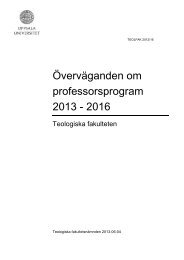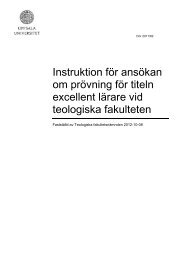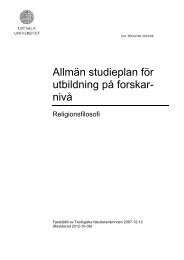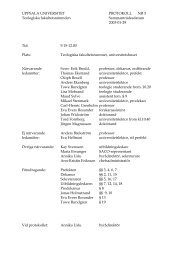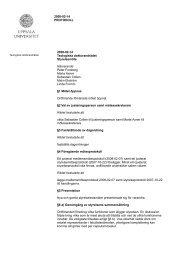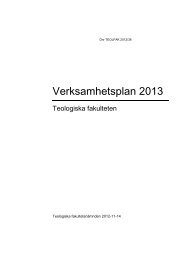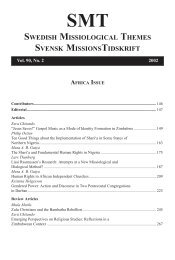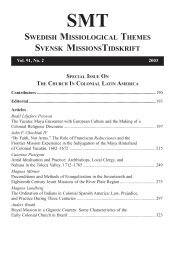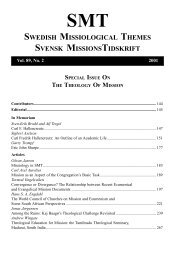SWEDISH MISSIOLOGICAL THEMES SVENSK MISSIONSTIDSKRIFT
SWEDISH MISSIOLOGICAL THEMES SVENSK MISSIONSTIDSKRIFT
SWEDISH MISSIOLOGICAL THEMES SVENSK MISSIONSTIDSKRIFT
You also want an ePaper? Increase the reach of your titles
YUMPU automatically turns print PDFs into web optimized ePapers that Google loves.
512 Aasulv Lande<br />
What then about the conflict that was a dominating motive in Rimbert’s<br />
story? It was a conflict between “God and Satan”. Does the missionary of<br />
the 1960s enter into a conflict? Is this here a battle against Satan? According<br />
to Pierce Beaver, mission is about making people Christian – there are<br />
strong challenges from the urban, desacralised environment. And it is about<br />
a special focus on the marginalised; it can be people in diasporas but also<br />
intellectuals and “primitive peoples”. In these characteristics there is in<br />
itself a scheme of conflict with the forces that marginalise people. But it is<br />
doubtful if such a strong word as “Satan” is applicable for these conflicts.<br />
Interestingly enough Beaver counts interreligious dialogue as an important<br />
aspect of the Christian mission at that time. Here he refers both to the<br />
theologian Paul Tillich, the historian Arnold Toynbee, and the scholar in<br />
the history of religions Joseph Kitagawa and others engaged in interreligious<br />
dialogue. He lists the criteria that Tillich has made up for dialogue:<br />
“Acknowledgement of one another’s earnest conviction, participation only<br />
by persons with such convictions who can make the encounter a serious<br />
confrontation, the finding of common ground for discussion and mutual<br />
openness to criticism.” 16 Beaver claims “dialogue presupposes that the<br />
participants do not strive for conversion and restrain themselves from any<br />
form of coercion and pressure to achieve conversion”. 17 He does however<br />
see an important function of the dialogue in the witness and stresses that<br />
the Spirit is active in the dialogue. “Dialogue may be a form of witness to<br />
the Gospel that is more consistent with the spirit of Christ than many methods<br />
of the past”. 18 Beaver thus counts with a conflict with dehumanising forces<br />
and disbelief. But the conflict is de-personalised compared to the<br />
confrontation with Satan that Rimbert spoke of eleven hundred years earlier.<br />
Satan is “softer” in the missiology of the 1960s. There is an eschatological<br />
dimension, but it is weakened and pragmatic.<br />
After reading Pierce Beavers book from 1968 one is struck by how uncritical<br />
and unaware the author was about many sides of the missiological problem:<br />
16 Beaver 1968: 122<br />
17 Beaver 1968: 124<br />
18 Beaver 1968: 124



